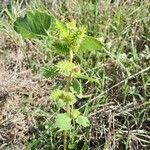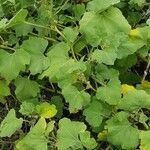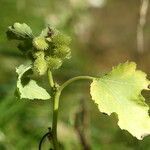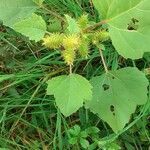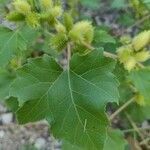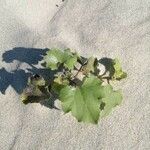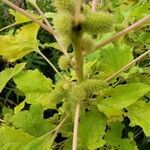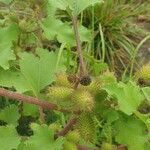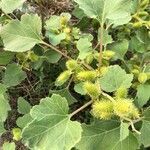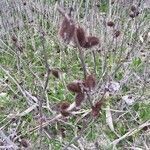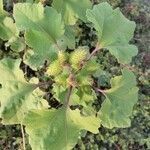Herbs, annual, 20-120 cm; nodal spines absent. Petiole 3.5-10 cm, not winged; median cauline leaves ovate-deltate, 9-25 cm, papery, densely scabrid on both surfaces, base shallowly cordate to broadly cuneate, margin irregularly dentate, often obsoletely 3-lobed, apex acute. Capitula monoecious. Male capitula in terminal umbels; phyllaries 1-seriate, oblong-lanceolate, ca. 2.2 mm; outer paleae oblong-lanceolate, inner paleae lanceolate, ca. 2.2 mm; corolla white, tubular, ca. 2.5 mm, 5-dentate. Female capitula axillary; phyllaries 1-seriate, oblong-lanceolate, ca. 3 mm, inner bracts connate with outer paleae. Burs sessile, oblong, ellipsoid, or ovoid, 10-18 × 6-12 mm, densely puberulent, 2-beaked. Fl. Jul-Aug, fr. Sep-Oct. 2n = 36.
Coarse, annual herb, up to 1.5 m high; stems reddish or brownish. Leaves alternate, petiolate, deltoid or broadly ovate, base cuneate, then cordate, margins coarsely and irregularly toothed. Male capitula terminal on short, axillary inflorescence; involucre short; bracts few, narrow, in 1 or 2 rows; receptacle hemispherical, paleate; corolla tubular, 5-toothed; anthers with small apical appendage, base obtuse; filaments connate; ovary abortive; style undivided. Female capitula below; involucre completely enveloping 2 female florets, 2-locular within; corolla absent; style branches long, linear, acute. Pappus absent. Cypselae ellipsoid, closely covered in hooked spines, inconspicuous.
Erect annual, up to c. 1 m tall. Stems sparsely to moderately hairy above, becoming glabrous below, usually branched. Lvs long-petiolate, spineless; lamina green with with scattered short, scabrid, hairs and glands on both surfaces, broad-ovate, irregularly serrate, 3-lobed or not lobed, cordate or truncate at base, 5-15 cm long; uppermost lvs smaller and narrower. ♂ and ♀ capitula in axillary or terminal clusters; ♀ sometimes solitary; ♂ with numerous florets. Fruiting involucre sparsely to moderately scabrid, sometimes almost glabrous at maturity, 15-25 × 8-20 mm; prickles hooked, glabrous or hairy, 3-5 mm long; beaks 2, conspicuous, 4-6 mm long.
Annual herb, up to 1.5 m high; not spiny. Leaves alternate; blade deltoid or broadly ovate, simple or 3-to 5-lobed, base cordate, margins coarsely and irregularly dentate, concolorous; petiole up to 100 mm long. Heads unisexual, discoid; male heads many, terminal in short axillary inflorescences; female heads several below them. Involucral bracts in male heads few, narrow, 1-or 2-seriate; in female heads enveloping female florets, covered in hooked spines. Flowers: corolla of male florets greenish or yellowish, absent in female florets; Dec.-Mar. Fruit with cypsela obovoid or oblong, enveloped by hardened, spiny, involucral bracts. Pappus absent.
Coarse annual herb to 1.5 m high; stems scabridulous, often reddish.. Leaves broadly deltate or broadly ovate, simple or 3–5-lobed, 5–12 cm long, 4–18 cm wide, base cordate as well as broadly cuneate, margins coarsely crenate, apex acute or obtuse, scabrid on both surfaces; 3-veined from base; petiole to 12 cm long.. Male capitula terminal on short axillary branches; involucre ± 3 mm long; corolla ± 2.5 mm long.. Female capitula to 4 mm long, with connate involucre.. Fruit ellipsoid, 1.5–2.3 cm long, covered in hooked spines 3–4 mm long, apex acute.. Fig. 178 (page 818).
A coarse annual herb to c. 1.5 m, stem brownish or reddish, unarmed. Leaves alternate, petiole up to c. 10 cm long, lamina up to 12 x 8 cm, deltoid or broadly ovate, simple or 3-to 5-lobed, margins coarsely and irregularly toothed, base cuneate adjacent to the petiole, then cordate, hispid, green, concolorous. Male heads terminal on short axillary inflorescences. Female heads below them. Fruiting heads (burs) ellipsoid, 1.5-2.5 cm long, closely covered in hooked spines and crowned with 2 conspicuous horns longer than the spines.
A stiffly branched annual herb. It is 1.2 m tall. The leaves are alternate and oval or triangle shaped with a heart shaped base. The flower heads are greenish. Male and female flowers are separate but on the same plant. They are 5-6 mm across and in clusters at the side. The fruit are 14-18 mm across.
Plants 10–80(–200) cm; nodal spines 0. Leaves: petioles 20–100(–140+) mm; blades suborbiculate to ± pentagonal or deltate, 4–12(–18+) × 3–10(–18+) cm, sometimes palmately 3–5-lobed, abaxial faces green, hirtellous. Burs 10–30+ mm. 2n = 36.
Annual herb, up to 1.5 m high, not spiny. Leaves deltoid, cordate at base, concolorous. Flowers greenish or yellowish.
